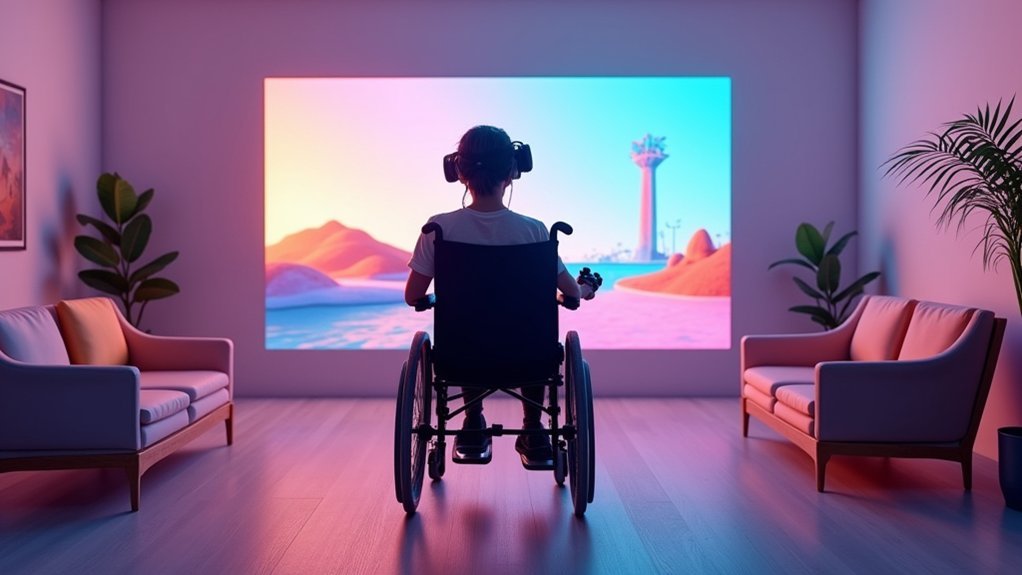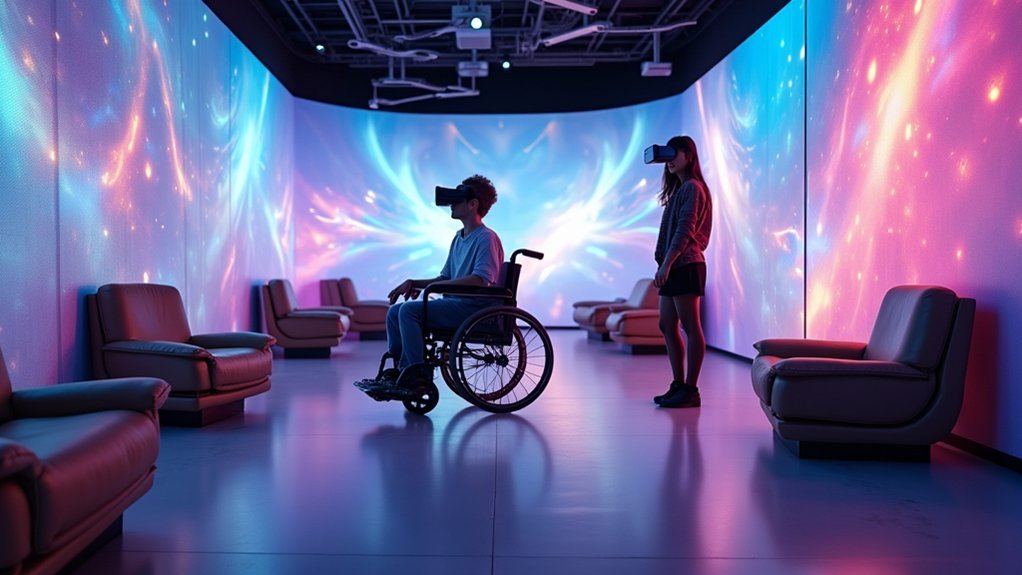You’ll need to design your VR spaces with 36-inch minimum path widths and position all interactive objects at waist height for wheelchair accessibility. Implement adjustable avatar systems that calibrate to seated positions, like those used in “Hover Junkers” and “Job Simulator.” Create customizable control mappings and offer teleportation-based navigation as alternatives to standard movement. Test your designs with actual wheelchair users to validate functionality and reduce physical strain. The complete implementation process involves several additional technical considerations.
Physical Space Requirements for Wheelchair Users in VR

When designing virtual reality environments for wheelchair users, you must prioritize specific physical space requirements that differ markedly from traditional VR setups. Your paths need at least 36 inches of width to guarantee proper maneuverability without obstruction.
You’ll want to position all interactable objects at waist height, making them accessible without requiring uncomfortable reaching or bending motions from a seated position. Control panels should stay within one foot of head height for easy engagement.
Avoid placing any objects on the ground, as they create significant accessibility barriers. Implement customizable settings that allow users to adjust their virtual height and avatar head models.
These physical space requirements directly impact the immersive experience, guaranteeing wheelchair users can navigate your virtual reality environment with complete accessibility and comfort.
Adjustable Avatar Height and Positioning Systems
Since traditional VR experiences assume standing users, you’ll need adjustable avatar height and positioning systems to create truly inclusive virtual environments for wheelchair users.
These systems allow customization of virtual presence, guaranteeing proper interaction with environments without physical limitations creating barriers. Applications like “Hover Junkers” and “Job Simulator” successfully demonstrate head model adjustments that enhance wheelchair accessibility and user experience.
You should position interactable objects at waist height to accommodate seated users effectively.
Additionally, make sure control panels and navigation interfaces remain within comfortable reach through proper positioning systems. This approach greatly improves engagement capabilities for wheelchair users.
Early integration of adjustable avatar systems during VR development is vital for addressing accessibility barriers from initial design stages.
Controller Remapping and Motion Accessibility Tools

You’ll find that controller remapping tools like MotionBlocks revolutionize how you interact with VR by letting you customize game controls based on your specific mobility capabilities.
You can select simple geometric shapes that represent your achievable movements, which the system then translates into the complex 3D actions VR games require.
This movement translation technology modifies how VR platforms interpret your controller inputs, creating a personalized gaming experience that matches your physical abilities.
MotionBlocks Customization Features
Although traditional VR controls can present significant barriers for wheelchair users, MotionBlocks revolutionizes accessibility by enabling you to completely customize how VR platforms interpret your controller inputs.
This wheelchair-accessible solution transforms VR game controls through innovative customization features that adapt to your specific mobility limitations.
You can select simple geometric shapes to visually represent your achievable user movements, creating an intuitive configuration system for tailored gameplay experiences.
MotionBlocks translates your actual movements into required game actions, delivering a truly accessible VR experience.
Key customization features include:
- Visual geometric shape selection for movement representation
- Intuitive control remapping for 3D space navigation
- Personalized input translation based on individual capabilities
- Reduced fatigue through motion accessibility optimization
This tool proves that thorough motion accessibility can enhance VR gaming for everyone.
Movement Translation Technology
When you engage with MotionBlocks’ movement translation technology, the system intelligently converts your physical capabilities into precise game controls that match your individual range of motion. This virtual reality accessibility breakthrough transforms limited mobility into customizable controls by translating simple movements into complex game actions.
| Movement Type | Traditional Control | MotionBlocks Translation |
|---|---|---|
| Head Tilts | Full body gestures | Directional commands |
| Hand Gestures | Large arm movements | Precise interactions |
| Eye Tracking | Walking/stepping | Navigation controls |
The movement translation technology enables inclusive gaming across social spaces and game platforms by recognizing your achievable motions through simple shape selection. You’ll experience reduced fatigue while maintaining full user experience functionality, proving that accessibility features can enhance rather than limit virtual reality environments for everyone.
Reachable Object Placement and Interaction Design
Since wheelchair users navigate virtual environments from a seated position, your object placement strategy becomes the foundation of accessible VR design. Strategic positioning of reachable objects guarantees wheelchair users can engage fully without encountering accessibility barriers that traditional gameplay mechanics often create.
Your interaction design should prioritize inclusivity through thoughtful placement decisions:
- Position interactive elements at waist height for ideal accessibility
- Keep control panels within one foot of head height for seated users
- Avoid placing essential objects on the ground level
- Design VR environments with early accessibility considerations
When you implement these design considerations from the project’s inception, you’ll eliminate mobility limitations that exclude users.
Your accessible approach transforms virtual spaces into truly inclusive environments where all users can participate equally, regardless of their physical capabilities or seated position.
Seated Play Optimization and Height Accommodations

Proper object placement forms just one piece of the accessibility puzzle—your VR environment must also accommodate the full range of seated play mechanics that wheelchair users require. Seated play optimization involves designing interactions that let users crouch or duck while remaining seated, removing accessibility barriers that could limit engagement.
| Design Element | Height Accommodation |
|---|---|
| Avatar height models | Adjustable to user preferences |
| Interactable objects | Positioned at waist height |
| Virtual control panels | Within one-foot range of head height |
| Menu systems | Easily accessible from seated position |
Implementing these height accommodations during the design phase creates a more accessible experience for all users. You’ll guarantee wheelchair users can fully participate in your virtual environment, transforming potential frustration into an engaging experience that welcomes everyone.
Navigation Solutions for Limited Mobility Users
You’ll need flexible navigation systems that adapt to your physical capabilities rather than forcing you to conform to standard movement controls.
MotionBlocks control remapping lets you reassign movement functions to inputs that work best for your mobility level, whether that’s using head tracking, eye movement, or accessible controllers.
Your virtual environment should also feature spatial movement adaptations like teleportation points, reduced-motion alternatives, and customizable movement speeds that accommodate your specific needs.
MotionBlocks Control Remapping
When traditional VR controls don’t match your physical capabilities, MotionBlocks offers a groundbreaking solution that lets you customize game inputs to work with your actual range of motion.
This innovative tool transforms how users with limited mobility experience VR game controls by allowing you to remap inputs specifically for your needs.
You’ll select simple shapes representing achievable 3D movements, making configuration intuitive and personalized. MotionBlocks translates your user movements into required game actions, eliminating the need for large or dramatic gestures typically demanded by VR applications.
- Customize controls to match your physical capabilities and comfort level
- Select simple shapes that represent your achievable movement range
- Reduce fatigue while maintaining full gameplay enjoyment and immersion
- Experience proof-of-concept technology advocating for widespread accessibility features
This system promotes inclusivity by demonstrating how proper motion remapping enhances VR experiences for everyone.
Spatial Movement Adaptations
Maneuvering virtual worlds becomes seamless through spatial movement adaptations that transform how you explore VR environments from a wheelchair.
These wheelchair-accessible virtual reality modifications include adjustable head models that automatically calibrate to your seated position, guaranteeing natural avatar representation during gameplay interaction.
You’ll find interactable objects strategically positioned within accessible range at waist height, eliminating the frustration of unreachable items.
Customizable control mappings translate your achievable movements into complex navigation commands, while static hitboxes remove the need for extensive physical motion during combat or puzzle-solving.
These spatial movement adaptations create inclusive experiences where limited mobility doesn’t compromise your virtual adventures.
Testing and Validation With Wheelchair-Using Participants
Although developing accessible VR technology requires theoretical frameworks, validating these concepts through real-world testing with wheelchair users proves vital for creating truly inclusive virtual environments.
University of Waterloo researchers conducted extensive testing with wheelchair participants to evaluate MotionBlocks functionality. Eight participants provided essential feedback during MotionBlocks testing, reporting increased enjoyment and reduced fatigue compared to standard VR experiences.
This testing phase revealed how wheelchair users can customize their VR gameplay by remapping controls and selecting movement-appropriate shapes in 3D space.
The validation process highlighted key accessibility requirements:
- Control customization – Participants could remap controls to match their mobility capabilities
- Reduced physical strain – Users experienced less fatigue during extended VR sessions
- Enhanced social interaction – Accessible environments improved engagement with other users
- Movement representation – Customizable shapes accurately reflected achievable motions for wheelchair users
Frequently Asked Questions
How Do You Make a Space Wheelchair Accessible?
You’ll need to install ramps instead of stairs, widen doorways to at least 32 inches, create accessible parking spaces, guarantee smooth flooring surfaces, and position light switches, handles, and controls at reachable heights.
How to Create VR Rooms?
You’ll design VR rooms using 3D modeling software, define spatial boundaries, add interactive objects, program user interactions, implement lighting and textures, then test for functionality and performance optimization.
Is There VR Where You Can Walk?
You can walk in room-scale VR systems like HTC Vive or Oculus Quest that track your physical movements. However, these require standing and walking space, which creates accessibility barriers for wheelchair users.
How to Create a VR Environment?
You’ll start by choosing development software like Unity or Unreal Engine, then design 3D environments using modeling tools, add interactive elements, implement user controls, test thoroughly for functionality, and optimize performance for smooth VR headset compatibility.





Leave a Reply